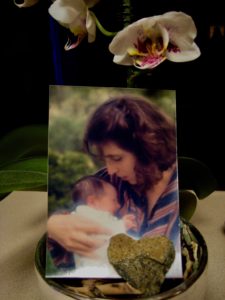
– Artwork © 2021 by Jan Ketchel
Love is the glue of Oneness. Ultimately, everything adheres as part of the Oneness, though in our journeys of separation, distinctions veil our underlying interconnectedness. Our soul’s evolution marks love’s stages of refinement, as we find our way home to the greater Oneness.
The journey of this life begins with separation from one’s most local oneness, what has been called one’s soul group. An analogy to this group might be the consortium of cells that make up an organ, say, the liver, in the human body. Though all cells in the body share an underlying similarity and interconnectedness, those of the liver share a more specialized cohesion that makes their grouping a unique cell group.
Similarly, one’s soul group has journeyed together in various permutations, as well as separately, to solve karmic challenges that impact the group. Individual successes contribute to group wholeness and preparedness to venture further into the ever-unfolding mystery of continued life.
The refinement of love through this life and beyond is the awakening and receptivity to the increasingly subtle dimensions of life and its greater interconnectedness. In journeying deeper into the ability to love all, one finds their way home to Oneness.
Entering a life on Earth, our individual soul begins a physical life through attachment to family. This is the first experience of love in this life, which is supported by many archetypal promptings to protect and nurture the young. Love at this stage is largely the meeting of basic needs, which allows development to proceed. Ruptures in family attachments are frequent and often provide the context for one’s karmic mission in this life.
For love to move beyond the narcissistic imperative to shore up the self, one must establish a well-grounded ego, capable of basic trust. To truly enter the world of relationship, one must be able to grant another their own existence beyond their ability to satisfy one’s personal needs. The refinement of love at this stage is the ability to authentically meet the soul of an other.
Love is further refined when one can value all life with equanimity. This is the love that values all peoples, in all cultures. This is the love that values the planet as a living being needing our loving support. This is the love that realizes that all beings, even our greatest enemies, are at various stages in their own refinement to love.
See all your worthy opponents as providing opportunities to refine your relationship with love. To love a petty tyrant, we must get beyond our attachment to experiences that rendered us victims. These are the greatest challenges of all, as they frequently result in confrontation with unresolved trauma that has been walled off by a moat of defenses.
These journeys of recapitulation and resolution take us into the core issue of love, within the self: total acceptance of all one has experienced, all that one has done, and all that has been done to one. This is the essence of soul retrieval, a total consolidation of self.
Full acceptance includes the knowing that we live in a predatory universe and that our pure innocent selves will be wounded in life. Retrieving and freeing the wounded parts of ourselves is followed by a matured innocence daring to venture back out into the world, despite the known and unknown dangers.
Perhaps the finest refinement of love is helping, as a way of life. The first impulse many get after a Near Death Experience (NDE) is to write a book, to share the good news of life after life with others. To gift others with the knowledge we have gained aids all in their personal journeys of love’s refinement.
Of course, no-one can ever carry nor solve the burdens of others, but one can offer love, patience and knowledge to another in their own encounters with the predatory universe. This is love freely given, no expectation or need for reciprocity.
All life journeys are journeys in the refinement of love. The greater the refinement, the greater the advancement in soul groups, as they join with fellow soul groups on that ultimate journey of Oneness, and then, of course, beyond.
In refinement,
Chuck




